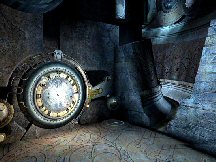Uru: The
Path of the Shell (PotS)
What is this place? The surroundings are sumptuous, remarkably
realistic. It’s paradise for fiddlers. By “fiddlers” I mean gamers
who like to putter and tweak, trying combinations of things just to
see what might happen. The world of PotS is your laboratory, and you
are the mad scientist, adjusting settings, observing reactions.
Clues are everywhere. Sharp attention to detail is rewarded.
He Who Dies with the Most Toys…
Path of the Shell revisits a flamboyant character from Uru Prime – a
D’ni leader named Kadish. Kadish has an eye for beautiful things
(especially stained glass) and a flair for designing puzzles. In
PotS you play with more of his fantastical stuff. The game also
hints at further developments in the story of Yeesha -- Atrus and
Catherine’s otherworldly daughter.
We are the Music Makers, and We are the Dreamers of Dreams
The graphics in Path of the Shell are spectacular. Three dimensions
never looked so good. Into a secret room you go, down a corridor
bright with reflections and rippling water. Ages appear, accompanied
by the inimitable Myst groan. Music and sound effects add
tremendously to the impact of the game’s environments.
If you crave out-of-this-world exploration, you must play this game.
Uru comes closer than any game I know to creating worlds you can
live in. Graphical and aural intricacies abound. You can return over
and over with deepening insight into the gameworld and story. Like
other Myst games, PotS does not have a traditional plot, but
provides a background story and visual hints that advance the Myst
legend.
Plot Exposition – It has to go somewhere
PotS features a series of books called “Words” written by the
Watcher, a controversial figure in D’ni history. The books were
written as prophecy thousands of years ago, and the player
(particularly a player steeped in the Myst games and books) can find
many references to familiar characters from the past.
“Words” forms its own identification/interpretation puzzle as you
match characters to possible descriptions in the book. Here you can
also look for plot clues and try to wrest puzzle solutions from
tantalizing references. I loved doing this. I’m still doing it.
Suffice it to say, if you enjoy poring over texts laden with obscure
historical mysteries, there is plenty to keep you occupied. On the
other hand, if this activity leaves you cold, you can safely make it
through the game without consulting every word of the Watcher’s
books.
We Few, We Patient Few
As for the puzzles themselves, they feature multiple steps, all
integrated into the Age, storyline and central mystery. I found them
to be entertaining and ingenious. I progressed a long way into each
puzzle without needing more than an observant eye, persistence, and
a touch of imagination.
The final step (or two) in each of these puzzles, however, is very
difficult. It’s hard for me to imagine figuring out the last steps
completely on my own. Well, maybe with pots and pots of more time
and patience ….
A Stitch in Time (The Watched Pot)
The Path of the Shell has a lot to do with time. Time exploration
occurs throughout the game, and it is intriguing. If there is one
criticism I have of the game, though, it is the time I spent
twiddling my thumbs and staring at the screen. The hand of the clock
inches down. The load screen progression bar creeps forward. Tick
tock.
Is this fun? Waiting for the kettle to boil – is THAT fun? Okay, the
waiting fits the game’s schema/theme. It fits the game’s story.
Nevertheless, if I could turn back time, I would happily regain the
minutes I spent waiting, and instead spend them running or leaping
or tweaking or swimming.
Yes, you can swim in Path of the Shell. This is one of the best
innovations in the PotS levels. There are currents to play in,
watery places to explore, and different swimming strokes to try.
With care, you can coax odd-looking creatures into bobbing in the
water next to you. Swimming is a nice addition to the movement
challenges in the game (some leaping is required in PotS, but none
of the leaps are difficult).
Getting There from Here
Gamers who haven’t played a 3D game like Uru face a learning curve
with its interface. You can play the game mostly with the mouse in
first person perspective (this is how I played it). Or you can play
the game mostly using the keyboard in third person perspective. When
I first played Uru, I found the keyboard controls to be somewhat
awkward. Using the mouse was easy. Switching back and forth between
first and third person perspectives gives the gamer a lot of
flexibility, though the switching does slow the game down a trifle.
Quick List for Uru: The Path of the Shell
-
Fantastic 3D graphics.
-
Compelling worlds.
-
Interesting background
story. Somewhat amorphous game plot.
-
Can be played in either
first or third person perspective, with mouse or keyboard.
-
As in Uru Prime, there is
no traditional save system. Gameworld changes are saved
automatically, and location progress is saved through activation of
shell cloths.
-
The game installed and
played without a hiccup.
-
I played The Path of the
Shell as an expansion pack to Uru Prime (PotS, as well as the first
expansion pack, “To D’ni” are both included with Uru Prime in “Myst
Uru Complete Chronicles”.
-
Path of the Shell is aimed
at those who like to explore, experiment, and puzzle their way
through magnificent environments.
Final
Grade: A
Reviewer’s System Specs: Windows XP, Pentium 4 1.8 GHz with 512 MB
Ram, a 64MB Geforce 3 video card, Direct X 8.1, and a Sound Blaster
Live sound card. Graphics settings: Overall quality and texture --
Medium; Anti-aliasing –- Low; 32 bit color depth; 1024x768 screen
resolution.
design copyright ©
2004
GameBoomers
Group

